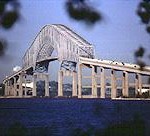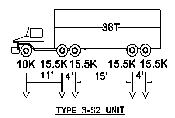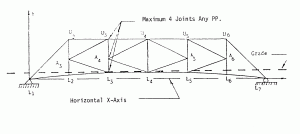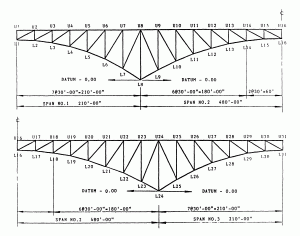Truss Rating and Analysis Program
Abstract
The computer program TRAP will perform an analysis or rating group loading of a simply supported or continuous span truss having up to six spans, in accordance with the latest AASHTO specifications. Also, the program is capable of performing the analysis and rating of a prestressed truss. Live load, using State of Maryland or AASHTO, is performed automatically. In addition, a general truck configuration or rail road loading (Cooper E60, E70, and E80) having up to 40 axles may be input for a special posting rating analysis.
The program uses the direct stiffness method to generate influence lines for truss member forces, cable forces, reactions, and panel point deflections. These influence lines then are used to determine the maximum compressive and tensile forces in each member under the indicated live loading. Capabilities include the automatic computation of Inventory, Operating, and Postings Ratings per AASHTO recommendations.
Output contains a verification of truss geometry and loading input, and includes member, cable and panel point data, truss heights, and geometric data for all members. Also included in the output are panel point dead loads, deflections, reactions, and a force summary due to DL + LL + I for all members. Finally, a summary of the truss rating analysis output is given. Output of a group loading analysis and the governing case can be obtained by inputting the appropriate program option.
Rating is allowed to use either Load Factor (LFD) or Load and Resistance Factor (LRFD) methods, which are based on the following criteria:
- Load and Resistance Design (LRFD) Rating, based on the AASHTO “Guide Specifications for Strength Evaluation of Existing Steel and Concrete Bridges,” 1989 and updated Interims;
- National Bridge Inventory (NBI) Rating, based on the AASHTO “Manual for Condition Evaluation of Bridges,” 1994 amd updated Interims;
- Load Factor (LFD) Rating, based on the AASHTO “Guide Specifications for Strength Design of Truss Bridges (Load Factor Design),” 1985 and updated Interims.
- New Load and Resistance Factor Design (LRFD) based on the AASHTO LRFD Bridge Design Specifications, 1998 – 2000 Interim Revisions.
Program Scope
- Conforms to the latest AASHTO Specifications for design and Guide Specifications for rating, Working Stress Design (WSD), Load Factor Design (LFD), and Load and Resistance Factor Deaign (LRFD);
- Automated DL for all construction conditions including ties;
- Automated LL for AASHTO, Interstate, AREA, state specified and special trucks, simultaneously or separately;
4. All impact factors are calculated automatically, either on the basis of the actual span length or loaded lengths (where appropriate)
5. Bridge may be determinate or indeterminate and of any configuration (e.g., deck truss, through truss, etc.);
6. Maximum positive and negative effects are given for all members and cables, reactions, and deformations;
7. User-specified truck loadings;
8. User can specify different levels of output;
9. Influence line option;
10. Combination of loads;
11. Complete analysis of prestressed cable truss system;
12. Complete rating for all members and all input trucks.
13. Both English and S.I. Units allowed
14. WINDOWS based program including Input, Run, Graphic, Print and Help utilities.









